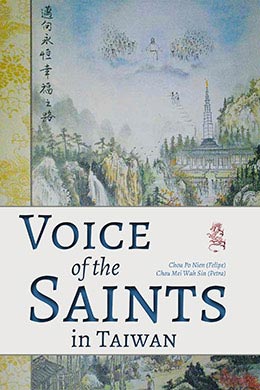Faith in Every Footstep
Local Leadership and Fortieth Anniversary (1990–99)
Chou Po Nien (Felipe) (周伯彥) and Chou Sin Mei Wah (Petra) (周冼美華), “Faith in Every Footstep: Local Leadership and Fortieth Anniversary (1990-99),” in Voice of the Saints in Taiwan, ed. Po Nien (Felipe) Chou (周伯彥) and Petra Mei Wah Sin Chou (周冼美華) (Provo, UT: Religious Studies Center; Salt Lake City: Deseret Book, 2017), 251-286.
The Church continued to grow and mature throughout its first forty years among the Chinese people in Taiwan. In the 1990s, the number of stakes in Taiwan doubled from three to six. There was one stake organized in the 1970s, two in the 1980s, and three in the 1990s, all staffed by local members. Additional leadership roles were given to local Chinese members during this decade, as they exercised “Faith in Every Footstep,” the theme for the Church’s pioneer sesquicentennial in 1997. In 1996, forty years after the first missionaries arrived in Taiwan, the Church News reported there were two missions with more than 300 missionaries, four mission districts, and four stakes with about 22,000 members in twenty-two wards and thirty-one branches in Taiwan.[1] Church membership grew from 17,239 to 26,805 between 1989 and 1999. The Church in Taiwan was abreast to the one in the United States, with its full range of programs, training, materials, and resources during this period.
Key events in the 1990s included the organization of additional stakes, the leadership training by visiting authorities and the new Asia Area Presidency, and the Church’s continuous focus on the family. The 1990s also included the call of the first Chinese temple presidents, Area Seventy, and General Authority, as well as Taiwan’s celebration of the fortieth anniversary of the Church on the island in 1996 and the reopening of the Kaohsiung Taiwan Mission. The call, preparation, and training of local leaders to assume these key leadership responsibilities would prove to face future challenges.
From Three to Six Stakes
During the 1990s, the number of stakes in Taiwan doubled from three to six. On Sunday, 18 December 1994, the Taichung Taiwan Stake was created with Chou Wen-Tsung (周文宗) called to serve as the stake president for the first stake organized in Central Taiwan.[2]
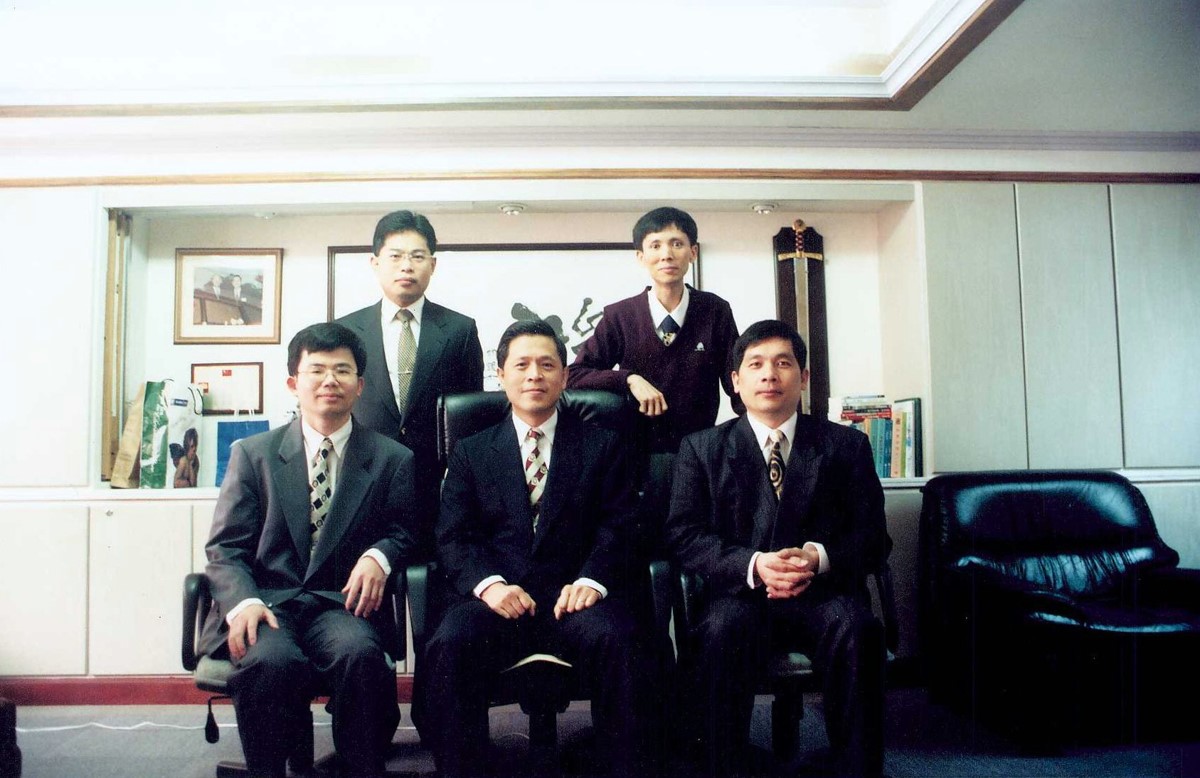 The Taichung Stake is organized in 18 December 1994. Front row from left to right: Juan Jui Chang, Chou Wen-Tsung, Chen Ting-Hui (first counselor, stake president, and second counselor). Back row from left to right: Ho Shao-Ming and Hsiao Wen-Hung (stake executive secretary and clerk). Courtesy of Phil and Brenda Frandsen.
The Taichung Stake is organized in 18 December 1994. Front row from left to right: Juan Jui Chang, Chou Wen-Tsung, Chen Ting-Hui (first counselor, stake president, and second counselor). Back row from left to right: Ho Shao-Ming and Hsiao Wen-Hung (stake executive secretary and clerk). Courtesy of Phil and Brenda Frandsen.
Two and a half years later, another stake was created, this time between Taichung and Kaohsiung. On Sunday, 15 June 1997, the Tainan Taiwan Stake was organized with Chen Hsien Chin (陳賢進) as the stake president.[3] The final stake created in the 1990s was the Taipei Taiwan Central Stake, which followed the realignment of the two existing stakes in Taipei. Tzeng Shuei-Tyan (Konrad) (曾水田) was called to serve as the stake president of the newly created Taipei Taiwan Central Stake on 24 May 1998.[4]
Training by the Brethren
As branches grew and became wards, branch presidents became bishops with added responsibility and authority. As districts grew into stakes, the responsibility and authority to preside over local members passed from mission presidents, the majority of whom were Americans, to stake presidents, all local leaders. The increased number of bishops and stakes also provided additional opportunities for the development and training of local leadership by members of the First Presidency and the Quorum of the Twelve Apostles. During the 1990s, local leaders in Taiwan received important training when they traveled to Hong Kong for area training meetings and when they welcomed visiting authorities to Taiwan.
For example, during an area training meeting on 9 June 1991, Elder Neal A. Maxwell of the Quorum of the Twelve discussed the Church’s General Handbook of Instruction, which provided instructions, practices, and policies of the Church. This direction was important to assist the local leaders in Taiwan, who were mostly converts and were unfamiliar with Church programs, increasing their understanding of how to administer the various programs of the Church. Elder Maxwell held similar meetings in subsequent years, including in November 1992 and 1993.[5] The Church’s Handbook of Instruction was an important tool to train local priesthood and auxiliary leaders throughout Taiwan. It increased understanding of how the Church is intended to function to strengthen individuals and families. In addition, training received by Church leaders from General Authorities and general auxiliary leaders informed and inspired local leaders in their roles and responsibilities in their personal lives, families, communities, and the Church.
Chang Chih-Hsun (張志勳), who later served as the stake president of the Taichung Taiwan East Stake, said that he often studied the Handbook of Instruction and encouraged other leaders in his stake to do the same. He added that the Handbook of Instruction and the training received during the visits by members of the Quorum of the Twelve and other area leaders helped local leaders understand the doctrines and apply them in their lives and ministry.[6] Sister Wang Lin Ping-Yuan (王林平苑) from Taipei said that among the changes that have helped the Church grow in Taiwan was the availability of the Handbook of Instruction to help the local leaders know how to administer the various programs of the Church.[7]
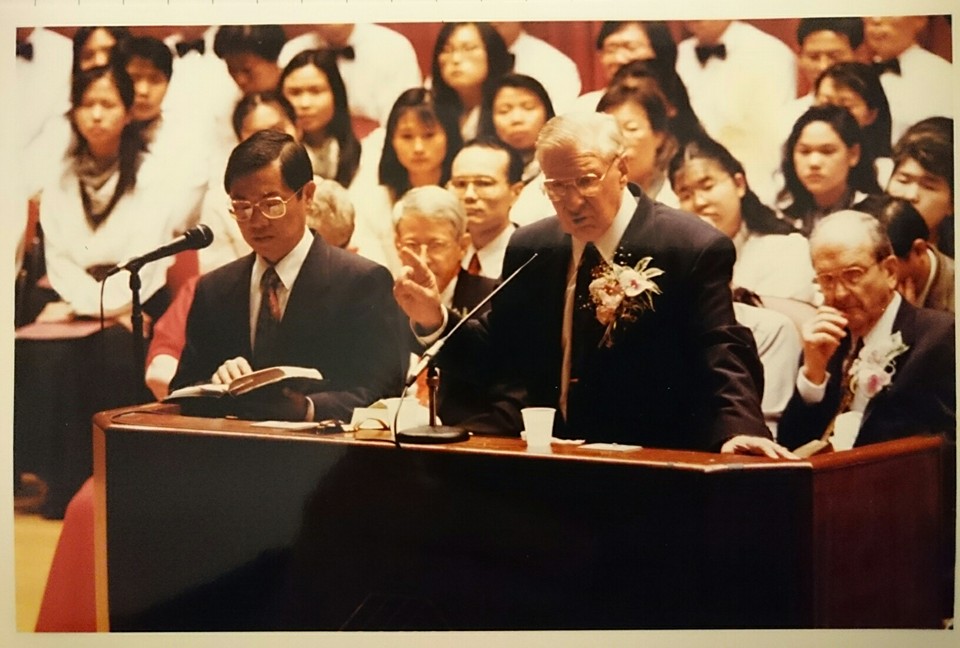 President James E. Faust, second counselor in the First Presidency, visits Taiwan in 1997. Courtesy of Liang Shih-Wei (Carl).
President James E. Faust, second counselor in the First Presidency, visits Taiwan in 1997. Courtesy of Liang Shih-Wei (Carl).
In addition, the Saints in Taiwan also had the opportunity to welcome various visiting authorities to the island. These leaders included Elders Joseph B. Wirthlin and Neal A. Maxwell from the Quorum of the Twelve in 1993 and 1994 respectively, Relief Society general president Elaine L. Jack in 1996, and President James E. Faust accompanied by Elder Russell M. Nelson in 1997.[8] Brother Chen Ye (Arnie) (陳曄), called to serve in the Taichung Taiwan Mission in 1993, said, “Elder Wirthlin shook hands with everyone [after the meeting], and when he shook mine he asked, ‘Have you served a mission?’ I told him I had already received my mission call and would be going soon, to which he said, ‘I am proud of you.’ I have never forgotten that.”[9] Besides encouraging the brothers to serve missions, Elder Wirthlin also encouraged them to have a current temple recommend, use it regularly, and not delay taking a sister to the temple.[10]
President Faust, then second counselor in the First Presidency, presided over regional conferences in Kaohsiung and Taipei on 27 April 1997. He noted that President Gordon B. Hinckley had a great love for the Saints in Taiwan and said to the sisters in attendance that “in our eyes, you are very important and precious.”[11] Wang Jung Ling (王榕翎) was among those assigned to welcome these leaders in 1997 and recalled that “as they walked passed me, I had a great feeling and spirit come over me. The Holy Ghost witnessed to me that they are prophets of God.”[12]
Ho Shao-Ming (何紹銘), the president of the Taichung Taiwan South Stake, noted that many priesthood leaders and sisters from Taiwan attended the training with President Faust and Elder Nelson in 1997, and that he personally learned from this meeting that every calling in the Church was important.[13] Tu Shi-Cheng (杜習程) from Chiayi recalled that President Faust asked Elder Nelson if he ever had to work on Sunday as a heart surgeon, to which Nelson replied, “Yes, if not my patients may die.” Tu said that after President Faust expressed gratitude for doctors, the police, and others who helped him travel on Sunday, “He reminded us to keep the Sabbath day holy, but not to criticize those who may have to work on the Sabbath.”[14]
Wang Jung Ling (王榕翎) noted that as the Saints in Taiwan were trained and taught by these Church leaders, their testimonies grew. Each visit and training by these leaders built the faith of the members and strengthened their testimonies.[15] Liao Ji Shuen (廖吉順), the president of the West Taichung Taiwan Stake, said that he learned much from the training and special witness of various members of the Quorum of the Twelve who have visited Taiwan. He added that while most others their age lacked energy to do much, these prophets and apostles continued to build the Church despite their age.[16]
“No Other Success Can Compensate for Failure in the Home” and the Family Proclamation
In the 1990s, the Taiwanese government made efforts to strengthen the family and sought the help of religious groups. On 3 May 1990, Taiwan’s Minister of Interior, Hsu Shui-teh visited Church leaders in Taipei as part of this effort. During the occasion of this visit, Minister Hsu quoted a statement made famous by President David O. McKay: “No other success in the world can compensate for failure in the home.” The Church produced and distributed stickers with the quote by President McKay to its own members and members of other faiths. This public relations campaign was successful and helped the people of Taiwan see the Church as a family-oriented church.[17] These stickers continue to be posted on doors, cars, scooters, and helmets of members of the Church throughout Taiwan today.
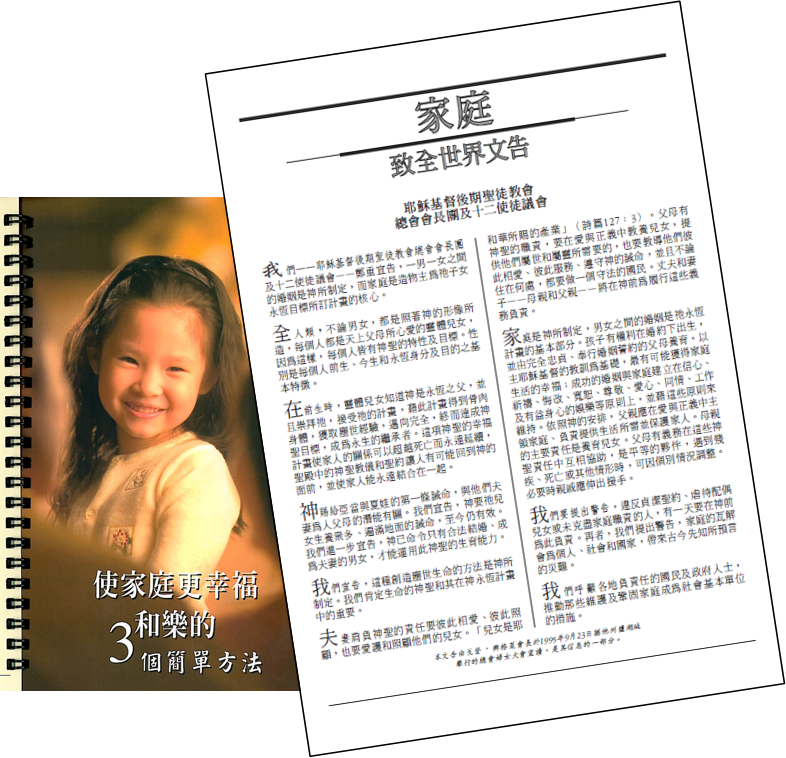 Copy of "The Family: A Proclamation to the World" issued in 1995 and booklet cosponsored by the LDS Church and Taiwan government. Courtesy of Chou Po Nien (Felipe).
Copy of "The Family: A Proclamation to the World" issued in 1995 and booklet cosponsored by the LDS Church and Taiwan government. Courtesy of Chou Po Nien (Felipe).
Huang Yong Da (黃永達), from Kaohsiung, recalled when he first saw the quotation, “No other success in the world can compensate for failure in the home.” Huang liked it so much because it rang true to him and stirred feelings in his heart. He was excited to share this quote with his wife, and they began to meet with the missionaries to investigate the Church. As they learned the missionary lessons, they loved the Church’s focus on the family. They were baptized together and served in various callings in the Church.[18] The statement continues to resonate with members and nonmembers in Taiwan.
On 23 September 1995, President Gordon B. Hinckley read “The Family: A Proclamation to the World” as part of his message at the general Relief Society meeting.[19] The proclamation was issued by the First Presidency and Council of the Twelve Apostles of the Church, and emphasized the importance of the family unit in today’s world. President Hinckley prefaced the reading of the proclamation by noting, “The world we are in is a world of turmoil, of shifting values. Shrill voices call out for one thing or another in betrayal of time-tested standards of behavior. The moral moorings of our society have been badly shaken.”[20] After noting that the family is ordained of God and that marriage is essential to the Creator’s eternal plan, the proclamation declares, “Happiness in family life is most likely to be achieved when founded upon the teachings of the Lord Jesus Christ,” and “Successful marriages and families are established and maintained on principles of faith, prayer, repentance, forgiveness, respect, love, compassion, work, and wholesome recreational activities.”[21]
Tu Shi-Cheng (杜習程), from Chiayi, said, “I love these nine principles for a successful marriage and family taught in the family proclamation so much that I committed them to memory.” During an interview with the mission president the next day, Tu was asked if he knew the nine principles of the family proclamation. He recalled, “I had already read, seen, and memorized it, so I just recited it to him. The mission president was so surprised I knew them by heart.” Tu was surprised that weekend when the mission president called him to be the first district president of the Chiayi Taiwan District.[22]
Ho Lee Mei Chen (何李梅珍), a member of the Taoyuan Taiwan Stake, said that “the proclamation has taught her that family relationships help develop divine characteristics such as faith, patience, and love.” She also observed that she experienced true happiness by trying to improve herself according to the proclamation.[23] A copy of the family proclamation was sent to various government and community leaders throughout Taiwan, where the Church has become known as a family-oriented church.
First Chinese Temple Presidents
In the 1990s, three couples served as temple president and matron for the Taipei Taiwan Temple, including two native couples. Barton S. Gillespie served as temple president from 1990 to 1993, followed by Wang Wei (王偉) from 1993 to 1997, and Hsieh (or Xie) Fan (謝凡) from 1997 to 2000. The latter two would be the first and second members in Taiwan to serve as temple presidents in Taiwan. Wang and Fan were early pioneers of the Church in Taiwan and shared duties as temple presidents in 1997, the same year the Church celebrated the sesquicentennial or the 150th anniversary of the arrival of the pioneers to the Salt Lake Valley. As stated earlier, the theme for the sesquicentennial was “Faith in Every Footstep.”[24] The faith and dedication of the early Mormon pioneers who crossed the plains in America are reflected in the lives of the first two native temple presidents in Taiwan.
Wang Wei
Wang Wei (王偉) and his wife, Wang Tan Hsiao-feng (王譚筱鳳), became the first Chinese members of the Church to serve as temple president and matron of the Taipei Taiwan Temple when they were called in 1993.[25] After meeting the missionaries, Wang Wei was baptized in September 1973. Wang Tan Hsiao-feng had recently given birth to a baby, so she was baptized shortly after. Wang Wei served in various callings, including service as a branch president, bishop, high counselor, and as a counselor in the stake presidency. Wang Tang Hsio-feng likewise filled many positions, including service as a Relief Society president. In 1981, they flew with their four children to the Tokyo Japan Temple to be sealed together as a family.[26]
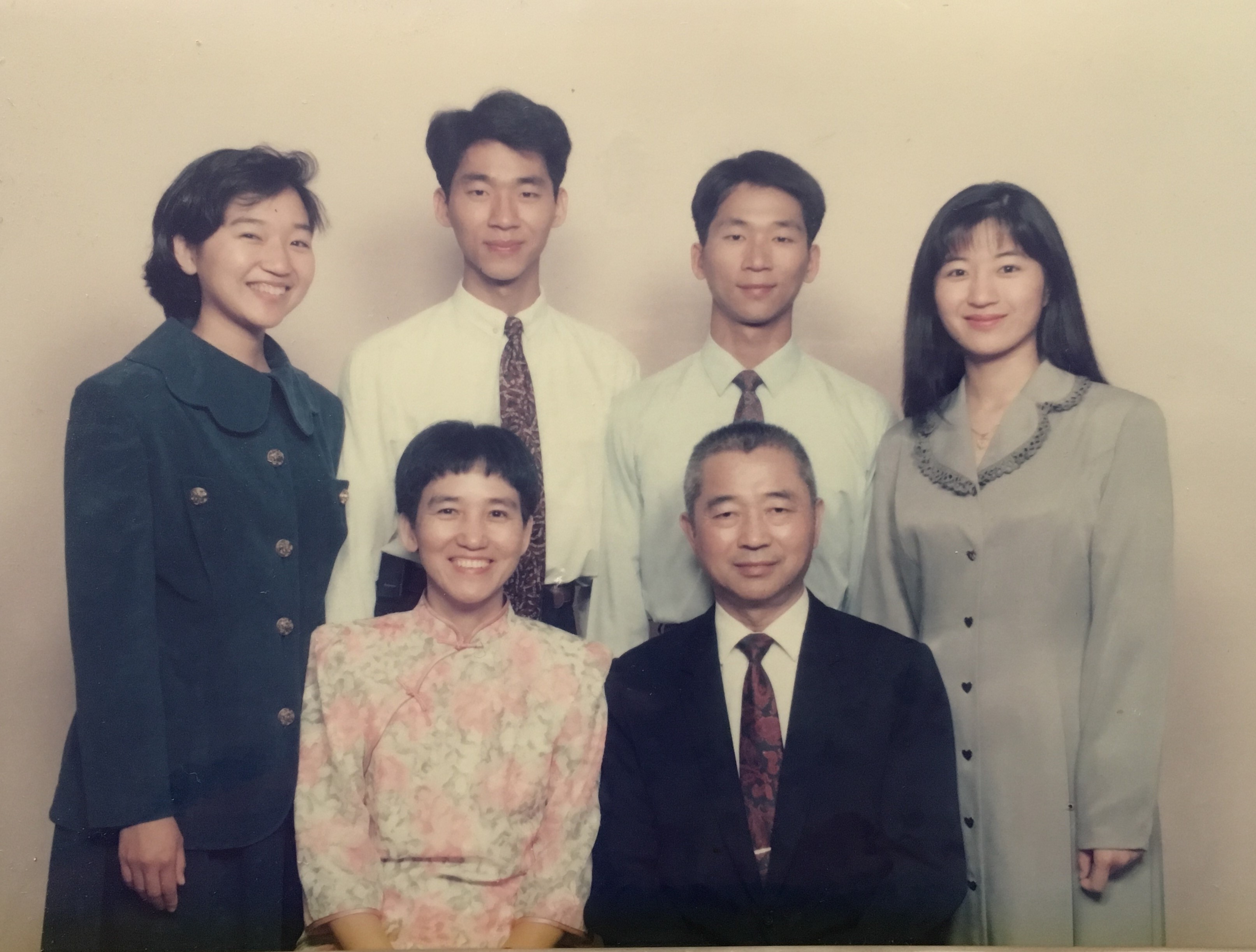 Wang Wei and Wang Tan Hsiao-feng and their children. They served as the first Chinese temple president and matron in 1993. Courtesy of Wang family.
Wang Wei and Wang Tan Hsiao-feng and their children. They served as the first Chinese temple president and matron in 1993. Courtesy of Wang family.
Their daughter, Wu Wang Hui-Ching (Emily) (吳王惠卿), remembered when her father was first called as a counselor in the temple presidency in 1990. She was at her parents’ home in Taiwan when a surprise phone call came from Church headquarters for that call. Her father served faithfully with the Taipei temple president, Barton Gillespie. Then, in 1993, her father was asked to go to Gillespie’s apartment to answer another telephone call from Church headquarters, and this time it was for a call to be the new temple president. Shortly thereafter, her parents flew from Taiwan to Salt Lake City, Utah, and met their children who were studying in Utah at the time. The family went to President Gordon B. Hinckley’s office at the Church Administration Building. Wu Wang Hui-Ching (Emily) said, “I was so curious to see what President Hinckley’s office looked like.” President Hinckley was then a counselor in the First Presidency, and after a brief visit, he set her father apart as the temple president for the Taipei Taiwan Temple. She recalled, “The Spirit was very strong when my parents were set apart.”[27]
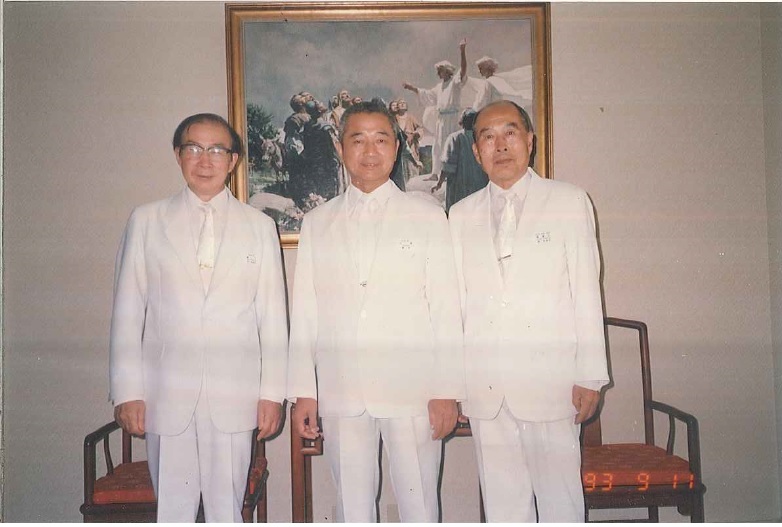 Wang Wei, the first Chinese temple president, with his counselors in 1993. Courtesy of Wang Family
Wang Wei, the first Chinese temple president, with his counselors in 1993. Courtesy of Wang Family
Later, President and Sister Wang would be asked by President Gordon B. Hinckley to extend their service, serving as temple president and matron for four years rather than the typical three years. Wu Wang Hui-Ching (Emily) recalled a special experience in which her father, while serving as a temple president, was blessed to be able to seal two of his daughters to their husbands, one in the Salt Lake Temple and the other in the Taipei Taiwan Temple. They also served several missions and continued to teach about the importance of the temple throughout their lives. They continued to serve in the temple over the years because they know their family is always blessed by their service.[28]
Hsieh Fan
Hsieh Fan (謝凡) and his wife, Lu Shou-yi (陸守義), were called as the next temple president and matron of the Taipei Taiwan Temple in 1997. Hsieh Fan was born in China on 23 August 1922 and served as a Catholic priest for eighteen years because he “saw the example of many good Catholic missionaries . . . and thought maybe China needed more of them to teach the people about Jesus Christ.” He was ordained a Catholic priest in Macao and was then assigned to Rome, Italy. While in Italy, he studied Italian and Latin. Then while in France, he studied French, Greek, Hebrew, English, Spanish, and German “so that he could better understand the original texts and the various translations of the Bible.”[29]
In 1967, he returned to Taiwan to teach at the Fu Jen Catholic University in Taipei at the request of Cardinal Yu Ping, but noted, “I spent eighteen years teaching and fulfilling my responsibilities as a priest. . . . I was very busy, but I wasn’t happy.” He had difficulty reconciling the fact that Catholic priests could not marry while the Bible taught, “It is not good that the man should be alone” (Genesis 2:18). In 1973, he resigned his teaching post and asked to be released from his priestly vows after deciding that “being alone forever wasn’t right.” He married a year later at the age of fifty but still longed for the opportunity to hold the priesthood and teach about Jesus Christ.[30] He noted his feelings as follows: “Giving up the priesthood was difficult for me. . . . I had been a priest for so long. Now I had given up everything that I had lived for up to that point in time. I missed sharing my knowledge and understanding of the gospel, something I had been able to do as a priest. I thought about becoming a minister in another church that allowed priests to marry. But because of my belief in the Catholic Church, I couldn’t make that change.”[31]
Three years later, he met two young missionaries from the Church. Hsieh recorded the following experience that helped him progress spiritually: “I thought that if their church were true, it would have a prophet and continuing revelation. I asked them why their church didn’t have crosses or crucifixes, and they said, ‘Because Christ is risen; Christ lives. If one of your friends or parents dies,’ they said, ‘do you take out a photograph of them dead and show it to everyone?’ I was spiritually touched by the wisdom of their response.”[32]
One of the missionaries, Elder Cenatiempo, told Hsieh Fan that “it was possible for him to receive the priesthood and perform certain duties within that priesthood.” Hsieh noted, “For the first time since I was released from the priesthood in my own church, I thought I might be able to hold the priesthood again.”[33] After studying the Book of Mormon, the Doctrine and Covenants, and learning about the priesthood, Hsieh Fan and his wife were baptized together in December 1977. They used every opportunity to testify of the restored gospel. Hsieh Fan even shared his testimony to scholars during the seven lectures he conducted at the International Conference for Christian Professors. He would later assist on the second Chinese translation of the Book of Mormon while serving as a high councilor in the Taipei Taiwan West Stake.[34]
Hsieh Fan served as a counselor in the Taipei temple presidency from 1986 to 1990.[35] Paul Hyer and Hsieh Fan had a close association while serving as the temple president and counselor in the temple presidency respectively. Hyer noted that “Hsieh Fan served with distinction in a number of important callings. . . . He has great faith, patience, and love for the people and the work . . . a humble servant of the Savior.”[36] In 1997, Hsieh Fan and his wife were called as temple president and matron. His wife, Sister Lu Shou-yi, had previously served as a temple worker, as an institute teacher, and as a part of other ward auxiliaries. Their son, Hsieh Ya-way (謝亞威), completed more than two thousand baptisms for the dead when he was a deacon.[37] Their story of faith and sacrifice is an example to Saints throughout Taiwan.
First Chinese General Authority
In June 1992, Elder Tai Kwok Yuen (戴國源) became the first Chinese General Authority when he was called into the Second Quorum of the Seventy by President Hinckley. The Tais were just finishing their service presiding over the Hong Kong Mission when they received a call. Elder Tai said that “the telephone call from President Hinckley changed everything for us. . . . We were very surprised, but [felt] very humble to receive this call. As I said to President Hinckley, ‘I will do my best.’” Elder Tai added, “We strongly believe in the Lord’s timetable. If we live worthy lives by following the precepts of the gospel, things will fall into the right place at the right time.”[38]
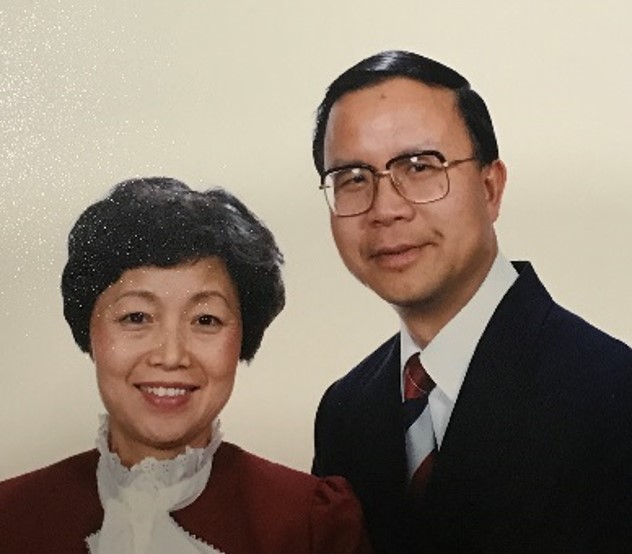 Elder Tai Kwok Yuen and his wife Tai Lai Hui Hua, circa 1989. Elder Tai was the first Chinese General Authority when he was called into the Second Quorum of the seventy in 1992. Courtesy of TaiKwok Yuen.
Elder Tai Kwok Yuen and his wife Tai Lai Hui Hua, circa 1989. Elder Tai was the first Chinese General Authority when he was called into the Second Quorum of the seventy in 1992. Courtesy of TaiKwok Yuen.
Many years earlier, after attending a sacrament meeting with a former neighbor and hearing all the missionary discussions, young seventeen-year-old Tai wanted to be baptized. His aunt, who raised him after his father was killed at war, initially refused to give permission but eventually consented after his many pleadings for almost a year.[39] Elder Tai recalled the following:
Elder Larry K. Browning informed me of a special baptismal service that was going to be held that Saturday. . . . On the morning of the service, I pensively asked my aunt [again]. She was busy burning some firewood, but to my infinite surprise she replied, saying, “Well, you’re a big boy now and old enough to make your decision.”
I took that answer as a “yes” and quickly gathered my baptismal clothes and ran to the bus stop. The meeting was held at the mission home. It was special in that Elder Mark E. Petersen and his wife were visiting Hong Kong that particular weekend. Elder Browning was more than surprised to see me, but quickly arranged for my baptism.[40]
Elder Tai was baptized on 9 June 1959 in the swimming pool of the Hong Kong mission home, and years later would return to serve as mission president and temple president in Hong Kong. He met his wife, Lai Hui Hua (Flora) (賴惠華), while organizing a branch choir. They married in 1966 and are parents to three children. Sister Tai was born in China and raised in Taiwan, where her father was a well-known minister. She was going to school in Hong Kong when she met the missionaries and received a testimony of the gospel at age eighteen. She said, “My parents were very sad, very angry when I wrote and told them I was taking the discussions from two Mormon missionaries and wanted to be baptized. . . . Their answer, of course, was no. I waited for a while and then was baptized.” She wrote home regularly which helped to soften her parents’ heart. After the Tais were married and had their first child, they visited her parents in Taiwan.[41] Elder Tai shared the following:
[Our son] Joseph was a cute little baby . . . and when we took him to visit, they were very proud of him. We told my wife's father that we had started a missionary fund for the young boy, and in 19 years he would be out with his grandfather doing missionary work. He was very impressed and jokingly said, “In 19 years, I will have my grandson competing with me for converts.” He told that with delight to his fellow ministers.
His heart was softened and our relationship normalized. He came to visit us many times. One time, he was at our home looking at the bookshelf where we had many Church books and manuals. He asked, “Where can I get a set of these books?” He wanted to take them back to his church and use them to teach. He . . . turned out to be the best non-member missionary we have.[42]
Sister Tai’s father was once asked about his opinion of the Church and responded, “A bad tree cannot have good fruit. Good fruit would not come from a bad tree.”[43] The Tais lived in Taipei from 1974 to 1976. Then after a brief time in England, they returned to Taiwan, living in Kaohsiung from 1977 to 1980. They visited with Sister Tai’s father many times, who said the Book of Mormon was written beautifully after reading portions of it in Japanese.[44]
Prior to his call as a General Authority, Elder Tai served in various callings, including time as a branch president in Taiwan and as a mission president for the Hong Kong Mission. He also worked in chemical marketing and lived in Taiwan, England, and the United States. Their family motto, which hangs on a scroll inscribed with Chinese characters, comes from Joshua 24:15: “But as for me and my house, we will serve the Lord.”[45] In 1995, the same year President Hinckley was sustained as the President of the Church, Elder Tai became the first Chinese member to serve as the Asia Area President, serving from 1995 to 1997.[46]
In the early 1990s, Tseng Chao Fu (曾照夫) was serving as the president of the Hsinchu Taiwan District. He remembered they had worked hard to grow and prepare his district to become a stake, but then changed their mind. Tseng said, “Elder Tai came to ask me why I didn’t want to create a stake, and I explained to him that the branches were too far and too spread out. I suggested it would be better to split it into two districts instead of creating one stake.” Elder Tai agreed and Tseng was called into the mission presidency when his two counselors were each called as district presidents for the Taoyuan and Hsinchu Districts. Tseng observed that Elder Tai understood the local needs and circumstances because he had lived and worked with the Saints in Taiwan.[47]
Hsu Ming-Chuan (許明泉) remembered when Tai served as the branch president of the West Kaohsiung Branch when they lived in Taiwan. There were about fifty to sixty members in that branch, where Hsu’s wife joined the Church, and they were grateful for the example from Brother and Sister Tai. Hsu later served as the first bishop of the Pingtung Ward from 1981 to 1997, when the Kaohsiung Taiwan Stake was organized. In 1997, Elder Tai would return to create the Pingtung Taiwan District and call Hsu as its first district president. Hsu expressed appreciation for the continued association that Church members have had with Elder and Sister Tai over their many years of service with the members in Taiwan.[48]
First Area Authority and Area Seventy from Taiwan
President Hinckley was sustained as the President of the Church in the April 1995 session of general conference. In a later session of that memorable general conference, he noted that “twenty-eight years ago the First Presidency was inspired to call men to serve as regional representatives of the Twelve. . . . At that time there were 69 regional representatives. Today there are 284.” He also noted that in recent years, the “[First] Presidency were inspired to call men from the Seventy to serve in area presidencies . . . well established and effectively functioning.” Then he extended an honorable release of all regional representatives effective 15 August 1995 and announced the call of area authorities,[49] as follows:
Now we announce the call of a new local officer to be known as an area authority. These will be high priests chosen from among past and present experienced Church leaders. They will continue with their current employment, reside in their own homes, and serve on a Church-service basis. The term of their call will be flexible, generally, for a period of approximately six years. They will be closely tied to the area presidencies. They will be fewer in number than have been the regional representatives. We are guided in setting up this new corps of area officers, as were our Brethren before us in the calling of regional representatives, by the provision contained in the revelation on priesthood, section 107 of the Doctrine and Covenants. After directions to the Twelve and the Seventy, the revelation states:
“Whereas other officers of the church, who belong not unto the Twelve, neither to the Seventy, are not under the responsibility to travel among all nations, but are to travel as their circumstances shall allow, notwithstanding they may hold as high and responsible offices in the church” (D&C 107:98).[50]
Shortly after, in April 1997, area authorities became Area Authority Seventies, and additional Quorums of the Seventy were organized. President Hinckley said, “We have had in between the general and local authorities for a period of time the Regional Representatives, now more recently these Area Authorities. We have determined to present to the conference the names of these Area Authorities to be ordained Seventies.”[51]
After Chang I-Ching (張漪清) and Liu Chun-hua (劉春華) served as regional representatives, Liang Shih-An (Kent) (梁世安) became the third and last person in Taiwan called as a regional representative in 1992, until all regional representatives of the Church were released and called as Area Authorities on 1 April 1995. At the time of his call as a regional representative, Liang had been serving as the stake president for the Taipei Taiwan West Stake since 1987. He was the only person to be called as an area authority from Taiwan. A previous chapter shared his experience growing up when his father became the first local branch president in Taiwan.
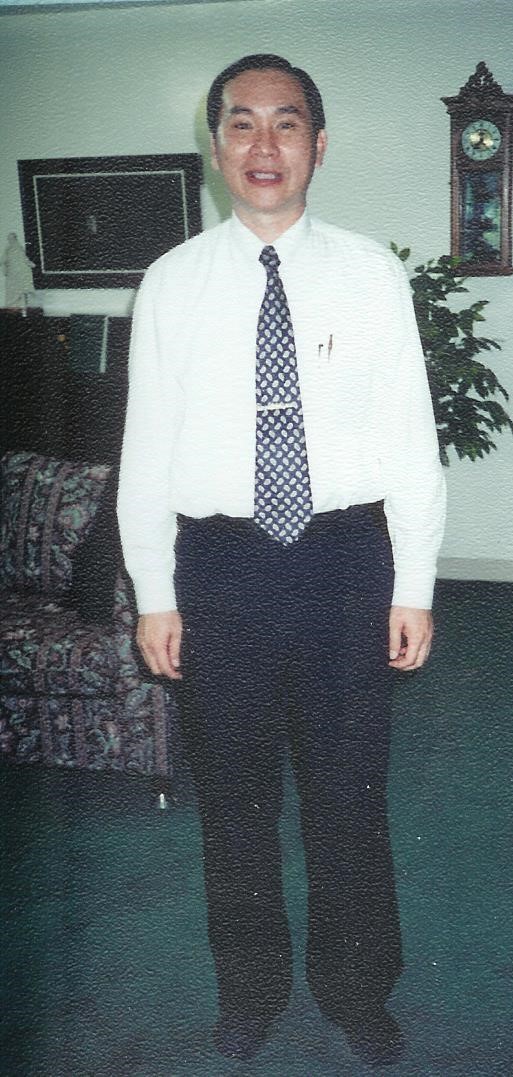 Elder Liang Shih-An (Kent) in 1999. He served as a regional representative (1992-95), as an Area Authority (1995-97), and as the first Area Seventy from Taiwan (1997-2003). Courtesy of Bob and Diane Murdock.
Elder Liang Shih-An (Kent) in 1999. He served as a regional representative (1992-95), as an Area Authority (1995-97), and as the first Area Seventy from Taiwan (1997-2003). Courtesy of Bob and Diane Murdock.
Liang’s call was changed again on 5 April 1997 when all area authorities became Area Authority Seventies. Although Taiwan has had other individuals called and set apart to serve as stake seventies before, the Church had discontinued all stake quorums of the seventies in 1986. President Thomas S. Monson, then First Counselor in the First Presidency, noted the change as follows: “It is proposed that we sustain the 134 Area Authorities, who are present with us today, as Seventies of The Church of Jesus Christ of Latter-day Saints to act in the office of Area Authority Seventy. These brethren . . . [included] Shih-An Liang.”[52] Additional information about the role and responsibilities of Area Seventies as well as subsequent brothers from Taiwan called to serve in this role will follow in the next chapter. Liang Shih-An (Kent) was the first member of the Church in Taiwan to be called to serve as an Area Authority and then as an Area Authority Seventy in 1997.[53] Liang Shih-An (Kent) worked as a professor and was part of the second generation of faithful Chinese Latter-day Saints; his parents had joined the Church in May 1958. His father, Liang Jun-sheng (梁潤生), served in a variety of callings during his years in the Church, including service as the first native branch president in Taiwan, a counselor in the first stake presidency in Taiwan, the second patriarch in Taiwan, a counselor in the Southern Far East Mission presidency, and so forth.[54] Elder Liang Shih-An (Kent) served the Saints in Asia faithfully until he was released in the October 2003 general conference.[55]
Taiwan’s Fortieth Anniversary
In 1995, Richard Stamps, president of the Taiwan Taipei Mission, proposed a celebration for the fortieth anniversary of the Church in Taiwan. According to President Stamps, the purpose of the celebration was “to increase public awareness of the Church for missionary work, strengthen local units through reactivation, and preserve memories and stories of the early pioneers.” Local units were encouraged to hold art contests in Primary, members prepared poems about missionaries, and leaders planned special firesides.[56]
There were plans for the dedication of the Hong Kong Temple in 1996 and a high likelihood that President Gordon B. Hinckley would come for that. So while in Hong Kong for an area leadership training, Stamps asked Elder L. Tom Perry from the Quorum of the Twelve, who presided at the meeting, about the possibility of inviting President Hinckley to the celebration in Taiwan. Elder Perry responded by saying, “Send him a letter.” Stamps sent the letter and was excited to receive a positive response.[57]
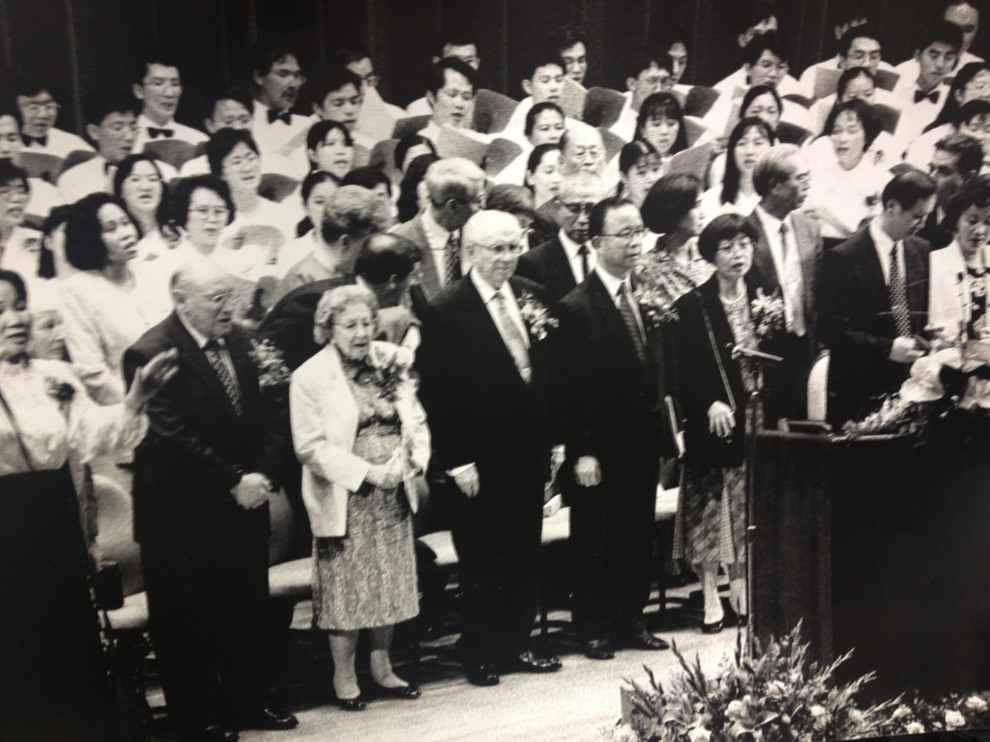 Elder Gordon B. Hinckley visits during the 40th anniversary of the Church in Taiwan in May 1996. From left to right: Elder Joseph B. Worthlin, Sister and President Gordon B. Hinckley, Elder and Sister Tai Kwok Yuen. Courtesy of Phil and Brenda Frandsen.
Elder Gordon B. Hinckley visits during the 40th anniversary of the Church in Taiwan in May 1996. From left to right: Elder Joseph B. Worthlin, Sister and President Gordon B. Hinckley, Elder and Sister Tai Kwok Yuen. Courtesy of Phil and Brenda Frandsen.
In 1996, the members of the Church in Taiwan commemorated the fortieth anniversary of the arrival of the first missionaries to the island. On 23 May 1996, President Gordon B. Hinckley visited Taiwan with Elder Joseph B. Wirthlin of the Quorum of the Twelve and their wives. Elder Tai Kwok Yuen of the Quorum of the Seventy conducted the meeting.[58] In the morning, President Hinckley spoke at a special meeting for current and returned missionaries on the island.[59] Brother Tang Tong-Yuan (湯東垣), who was a missionary in the Southern Far East Mission from 1966 to 1968, said, “I was asked to arrange overnight housing with member families for about 350 returned missionaries in Taiwan, who came a day early so they could attend the meeting at the Chin Hua Street chapel in the next morning.” Each person paid about five hundred New Taiwan dollars to cover travel and meals.[60] Tang and his son also created a special logo for the fortieth anniversary, featuring two missionaries riding together on their bicycles—one Chinese and one American.[61]
Then, in the evening of 23 May, about three thousand people gathered at the Taipei International Convention in Taipei to hear the prophet speak.[62] The meeting was conducted by President Tai, the Asia Area President. When President Hinckley entered the room, everyone stood, and Brother Lee Shih-Jung (Robert) (李世榮) felt a “warm witness that this was God’s prophet.”[63] Brother Chen Ye (Arnie) (陳曄), who sang with the choir, also had a similar experience. He said, “When the President Hinckley came in, I felt the Spirit enter the room and I knew he was a prophet.”[64] In the meeting, Elder Tai encouraged everyone to place the gospel at the center of their family, and Elder Wirthlin shared his testimony of Joseph Smith and of the Book of Mormon.[65] President Hinckley promised the Saints that “the work will prosper in this great land.”[66] Brother Wang Ling-Xing (王令行) remembered receiving a witness that “this is the Lord’s prophet” when he heard the prophet’s voice.[67] Sister Tsai Huang Li-Yu (蔡黃麗瑜) recalled the special meeting and President Hinckley’s focus on the importance of prayer and family home evening.[68]
Sister Tang Mei-Lan (Meryl) (湯美蘭) recalled being a stake music director, working with others to organize the choir for this event. Because the choir was limited to only 150 people, and there were many more that wanted to be in the choir for a chance to meet President Hinckley, auditions were held followed by practice over several weeks. They sang “We Thank Thee, O God, for a Prophet,” and several choir members were able to shake hands with President Hinckley.[69]
After visiting Taiwan, President Hinckley traveled to Hong Kong to dedicate the Hong Kong Temple on 26–27 May 1996. There were over five thousand people who attended the seven dedicatory sessions, including several members from Taiwan. Later that evening, President Hinckley visited mainland China.[70] A report from the Church Almanac reports the following:
On 27 May, after the last dedicatory session, President Hinckley became the first President of the Church to visit mainland China when he spent a night in Shenzhen, China, just over the Hong Kong-China border. In a visit arranged through the Church’s Polynesian Cultural Center in Hawaii, President Hinckley and others, including President Monson and Elders Maxwell, Wirthlin, and Tai, visited a “sister” cultural center, the Chinese Folk Villages; Splendid China, a miniature re-creation of various regions of China’s villages; and Windows of the World, a re-creation in miniature of some of the world’s major attractions. More than 500 costumed dancers and performers lined walkways to greet President Hinckley and others in his group during their brief stay.[71]
On 18–23 June, special activities and displays at the chapel on Chin Hua Street in Taipei helped to commemorate the fortieth anniversary of the Church in Taiwan. The open house was featured in the local media, including radio, television, and newspaper coverage. A cleanup service project was held at the site of Elder Mark E. Petersen’s dedication of the island, where members and missionaries joined for a reenactment of the reading of the dedicatory prayer.[72]
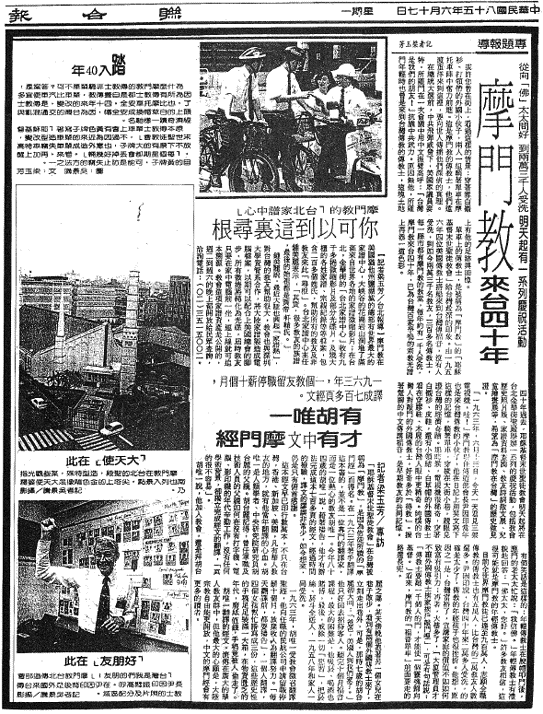 Local news article in 1996 about the "Mormon Church in Taiwan for 40 years." Courtesy of Richard Stamps and Wendy Jyang.
Local news article in 1996 about the "Mormon Church in Taiwan for 40 years." Courtesy of Richard Stamps and Wendy Jyang.
Liang Shih-Wei (Carl) (梁世威), then a member of the advisory group for the celebration, asked, “We have had open houses and big events in the past, but what do we have to show for it?” His question prompted the creation of the book The Taiwan Saints, coedited by Chiang Wei Ti (or Wendy Jyang Shamo) (江威締) and Richard Stamps, then president of the Taipei Taiwan Mission. Stamps said that this book was “in Chinese, by Chinese, for Chinese.” They gathered conversion stories from several members of the Church and their families for this book.[73] The stories published in this book came from many of the early pioneers of the Church in Taiwan, prepared and published in 1996, the year before the worldwide Church celebrated its pioneer sesquicentennial to remember and honor the early Mormon pioneers who arrived in the Salt Lake Valley in 1847. In a letter to Chiang Wei Ti, dated 16 February 1996, President Hinckley wrote:
I appreciate your recent letter concerning a book you are preparing for the 40th anniversary of our work in Taiwan.
I commend those responsible for this work on their desire to write down the history of the beginnings of the work in Taiwan and of the faithful, wonderful Latter-day Saints who joined the Church in early days and who, for the remainder of their lives, have been true and faithful . . .
I pray that our Father in Heaven will open the windows of heaven and pour down blessings on the heads of the faithful Saints in Taiwan.[74]
In 1997, referring to the early Mormon pioneers, President Hinckley said, “What a wonderful thing it is to have a great legacy, to have behind us men and women of faith and courage and determination and vision and understanding. . . . They were our forebears. They have passed to us the baton to carry on in the same spirit.”[75] A special lesson on the Mormon pioneers for the pioneer sesquicentennial was taught through the seminary and institute programs of the Church in Taiwan.[76] In many ways, pioneers of the Church in Taiwan also exercised “faith in every footstep” over the first forty years of its history in Taiwan and were “passing the baton” to a new generation of Latter-day Saints in Taiwan.
Kaohsiung Mission Reopens
On 1 July 1998, the Taiwan Kaohsiung Mission was reestablished with Robert Murdock
as the new mission president, fifteen years after it had been discontinued when the mission headquarters was moved to Taichung.[77] The announcement from the First Presidency noted that the Taiwan Kaohsiung Mission would serve about 4,700 members in two stakes and one district.[78] The reestablishment of the mission office and mission home in Kaohsiung was welcomed by the members in the southern region of the island. Along with the reestablishment of the third mission in Taiwan came an increased complement of full-time missionaries to assist with missionary efforts among the people of Taiwan.[79]
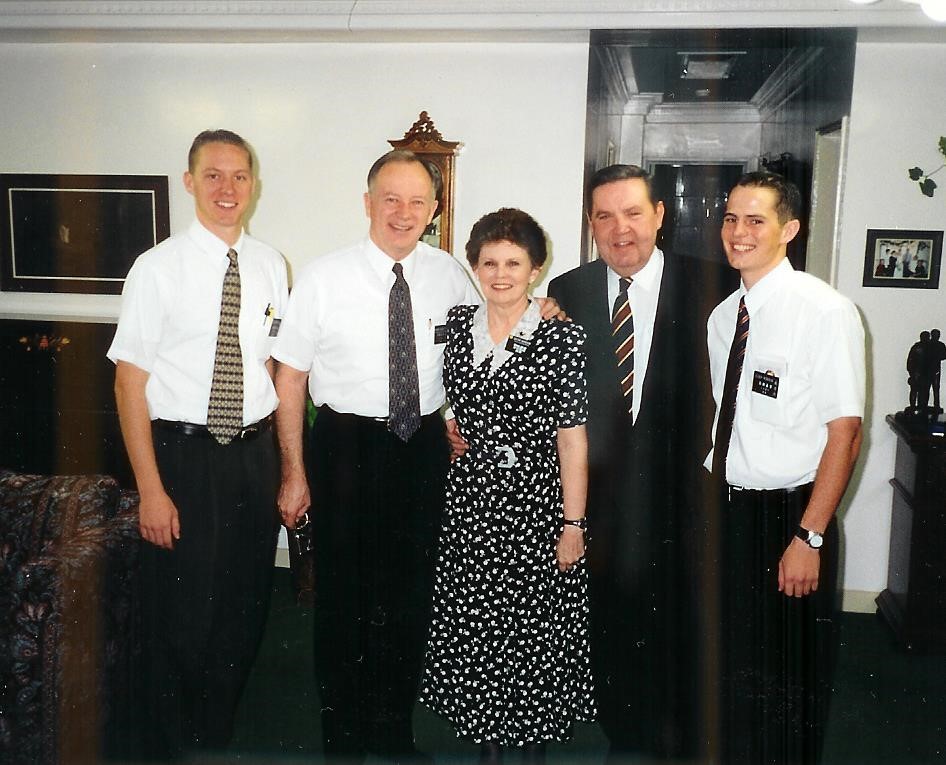 Elder Jeffery R. Holland visits newly reopened Kaohsiung Mission in 1999. From left to right: Elder Brianholt, President and Sister Bob Murdock, Elder Holland, and Elder Robison. Courtesy of Bob and Diane Murdock.
Elder Jeffery R. Holland visits newly reopened Kaohsiung Mission in 1999. From left to right: Elder Brianholt, President and Sister Bob Murdock, Elder Holland, and Elder Robison. Courtesy of Bob and Diane Murdock.
Besides the reopening of the Kaohsiung Taiwan Mission, the availability of language-learning materials increased the effectiveness of American missionaries in their labors. Early on, an unofficial missionary edition of the Book of Mormon was published and distributed by the mission office. This edition was printed in three columns, which included the English text, the romanized Chinese text (ping yin), and the Chinese characters. Since this edition was done by the mission office with untrained translators, some errors were expected. However, it was an important edition that helped increase the language proficiency of American missionaries in Taiwan.[80]
In 2005, a brown-and-black hardbound missionary edition was produced by the Taipei Mission, which was very popular among the missionaries. In 2008, after the release of the new 2007 Chinese translation of the scriptures, an official version of the missionary edition was published by the Church with the three columns and the subtitle “Language Study Edition.” This allowed members and missionaries throughout the world to obtain a copy of this edition through the Church’s distribution center.[81] Sister Brenda Frandsen said, “This was a huge help to our missionaries who were trying to learn the language!”[82]
New Asia Area Presidency and New Expectations
In August 1998, the First Presidency “announced changes in assignments for Area Presidencies.” Elder Cree-L Kofford was called as the new Asia Area President, with Elders Richard E. Cook and H. Bryan Richards as first and second counselors respectively.[83] This new Asia Area Presidency held special training meetings in Taiwan. Both men and women leaders from each unit were invited to the special training meetings. President Kofford noted that this was the first such training ever held in Taiwan or Asia. The training took place on 29–30 August in Kaohsiung and was for Church units in southern Taiwan. Similar training was then held on 5–6 September at the Chin Hua Street chapel for Church units in northern Taiwan.[84]
During the training, the Asia Area Presidency spoke of the responsibility of parents and bishops to help prepare the young men for missions and help them become completely converted to the work. They taught about the importance of setting goals and discussed how to use the key indicator report to help each unit improve, leaving a profound impression on the local leaders and moving the work forward in Taiwan.[85] Brother Ho Shao-Ming (何紹銘) recalled attending the leadership training meeting with the new Asia Area Presidency, who had high expectations. Ho was surprised to see how direct and demanding they were, while also expressing love and kindness to the leaders. When someone suggested they may be too busy to follow through with certain assignments, they were told by the Asia Area Presidency, “Don’t tell me you are busy, you don’t know busy!” Then, after the meeting, these leaders would stand by the door and give each person a hug before they left. Ho noted they had great expectations as well as great love for the Church leaders in Taiwan.[86]
In addition, whereas past training was typically provided by priesthood leaders, during this training, Sisters Kofford, Cook, and Richards also instructed local leaders. Sister Kofford met with the sisters to teach them that “they are the light of the world.” Then Sisters Cook and Richards modeled teaching and how to “plan with a purpose.” This was followed by a separate auxiliary leadership training: Sister Kofford with the Relief Society leaders, Sister Cook with the young women leaders, and Sister Richards with the primary leaders.[87] Sister Ho Chu Yu-Hsia (何朱玉霞) noted that she received much training that helped her later when she served as a young women president and later as a relief society president.[88]
This new Asia Area Presidency would bring early-morning seminary to Taiwan, even though some members never believed it would be possible. They would also emphasize the importance of key indicators to inform leaders of the needs of their units, and worked toward purchasing land to build additional church buildings and facilities for the Saints (both the early-morning seminary program and new buildings are discussed in a later chapter). Ho Shao-Ming, who later became the stake president for the Taichung Taiwan South Stake, noted that this Asia Area Presidency was responsible for bringing “many new buildings in Taiwan, and helping the local leaders understand how to use the key indicator reports.”[89] Elder Liang Shih-An (梁世安), who served as an Area Seventy, said that “President Kofford believed strongly in the importance of building members and adding more local missionaries . . . and increased land purchase in Taiwan to build new stake centers.” He also added that during this period of time, “there was a focus on the key indicators for each stake, district, ward, and branch . . . and an excitement to use these key indicators to improve performance.”[90]
The Voice of the Saints Becomes the Liahona Magazine
Prior to 1999, the local church magazine in Taiwan was called the Voice of the Saints. It was a blessing to many of the Saints in Taiwan, as it carried various faith-promoting articles along with talks from Church leaders given during the biannual general conference of the Church. Sister Tsao Fang-Ching (曹芳菁) from Taichung recalled that being a magazine representative was her first calling in the Church, and the pictures and stories helped her and others better understand the gospel.[91] Brother Chiang Tung-Chi (江東祺) from the Hsinchu Branch noted how he felt to receive these messages from general conference in this Church magazine.
As a new member of the Church I still have a lot to learn. Not many publications can touch my heart like the Shentu Chi Sheng (Chinese) [Voice of the Saints]. I was deeply touched and could not help but cry as I read the talks by the Brethren in the 160th semiannual general conference report. The whole issue is filled with love and spirituality. Other members in my ward were also impressed by the messages in that issue.
I am so grateful for the blessings from our Heavenly Father that my wife and I could be members of this true Church. We live the gospel principles diligently in order to teach our children and hope that they will both serve as missionaries for the Church someday.[92]
Others were touched by the pictures or illustrations provided. Chang Chin-kai (張欽凱) from the San Chung Ward in the Taipei West Stake noted the important role of the Church magazines in helping him while he served in the military.
Every time I receive Shentu Chi Sheng (Chinese) [Voice of the Saints], I have to read it from cover to cover. Often I will shed tears of joy as the Spirit touches me.
The magazine has been a great strength to me as I serve in the military service. I particularly felt encouraged by the painting that appeared in the August 1992 issue, depicting Helaman leading the army of 2,000 Ammonite youth. What a great example to us of righteousness and courage.[93]
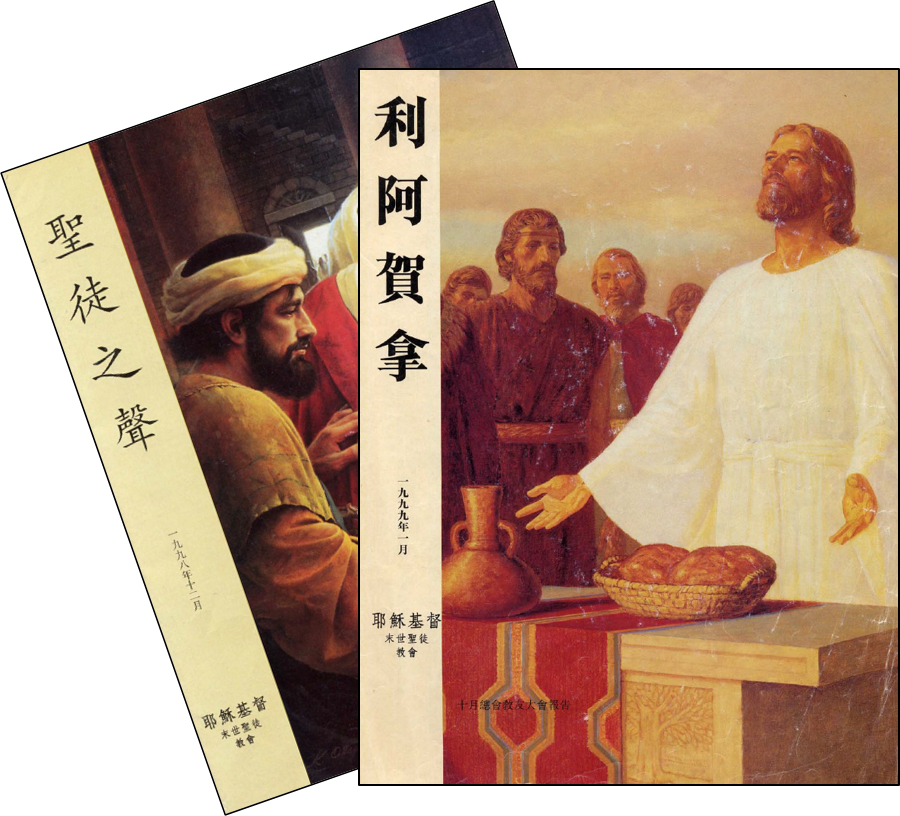 Chinese church magazine changes name in 1999. Last issue of Voice of the Saints (December 1998) and first issue of Liahona (January 1999). Courtesy of Chou Po Nien (Felipe).
Chinese church magazine changes name in 1999. Last issue of Voice of the Saints (December 1998) and first issue of Liahona (January 1999). Courtesy of Chou Po Nien (Felipe).
In 1999, the Voice of the Saints was renamed the Liahona.[94] Although the name changed, this Church magazine continued to provide faith-promoting articles as well as talks from general conference to bring the words of living prophets to the Chinese members of the Church in Taiwan and throughout the world. Liao Ai-lin (廖愛玲) from the Hualien District said, “Whenever I read the Liahona, my mind is calmed. . . . The words of the prophets and Church leaders touch my heart and have brought great blessings to my life.”[95] Chen Wang Cheng-cheng (陳王真真) from the Taichung Stake explained that the Church magazine provides answers:
Every month I eagerly await the arrival of the Liahona (Chinese). I know that within it is the spiritual food I need. Whether it is through an article or an illustration, I often find the personal revelation I desire.
I most love to read the January and July general conference issues. Reading them reminds me that Heavenly Father knows my current difficulties and gives me timely answers.
I also love the pictures of temples around the world. Although my family circumstances do not permit me to attend the temple, I know I will one day.
Thanks for the Liahona. It is my monthly access to the word of God.[96]
Some leaders provided military personnel with a free subscription of the Church magazines to strengthen them during their military service. Other leaders gave every new convert a free one-year subscription as a gift. A letter from the First Presidency on 1 April 1998 repeated the following invitation: “‘We urge all members throughout the world to subscribe to and read the Church magazines. We encourage priesthood leaders to see to it that every Latter-day Saint home has this opportunity’ (The First Presidency—Gordon B. Hinckley, Thomas S. Monson, James E. Faust, 1 April 1998).”[97]
Along with the name change for the Church magazine came adjustments to the timing for the general conference issue of the Liahona. Sister Chiu Hsin-Yao (Lena) (邱欣遙) worked as a translator under the supervision of Sister Tsai Lin (Cassandra) (蔡琳), then manager of the Translation Department at the Taipei Service Center. Chiu noted that with the Voice of the Saints, it would be several months before the talks from general conference would be translated. However, after this Church magazine was renamed the Liahona, the Translation Department in Taipei was asked to expedite the translation and make the general conference talks available the month immediately after the conference. Chiu noted that having the words of the prophets and apostles published and available so readily was a tremendous blessing for the Saints in Taiwan.[98] Furthermore, Sister Chang Wu Nan Hua (張吳蘭花) believed that the messages in the Church magazine had helped more members to learn directly from prophets and apostles.[99]
Conclusion
During the 1990s, the Church continued to mature in Taiwan as the Saints exercised “Faith in Every Footstep.” The number of stakes doubled compared to the previous period, and various General Authorities visited to provide training. In addition, the focus on the family and the family proclamation further strengthened the family-centered focus of the Church in Taiwan. The 1990s also saw the first Chinese temple presidents, the first Chinese General Authority, and the first Area Authority and Area Seventy following the sustaining of President Gordon B. Hinckley as the President of the Church. Finally, during this decade, various celebrations were held as part of the worldwide and local Church, including the Relief Society’s anniversary and pioneer sesquicentennial and the fortieth anniversary of the Church in Taiwan.
Notes
[1] Bruce Dean, “40 Years: The Church in Taiwan: Faithful Saints See Steady Growth in Island Nation,” Church News, 22 June 1996, 8–10.
[2] On 23 April 2000, President Chou Wen-Tsung (周文宗) was released and Juan Jui-Chang (阮瑞昌) was called and sustained as the new stake president to serve for the next ten years. Then on 2 May 2010, Chang Chih Hsun (張志勳) was sustained and set apart to replace President Juan as the new stake president. On 26 April 2015, following the division of the stake, the Taichung Taiwan Stake would be renamed the Taichung Taiwan East Stake, presided over by President Chang.
[3] President Chen Hsien Chin (陳賢進) presided over this stake for about nine years, serving from 1997 until 2006. On 8 January 2006, Chang Ting Tsung (張定宗) was sustained as the new stake president, nearly twenty years after his father, Chang I-Ching, was called as the first stake president in Taiwan in April 1976. The younger Chang served as a stake president until the fall of 2015 and was an example of the strength brought by the second generation of Taiwanese Latter-day Saints. Liu Te Lung (劉德龍) became the new stake president when President Chang was released on 6 September 2015.
[4] Tzeng Shuei-Tyan (Konrad) (曾水田) served as stake president until Liang Shih-Wei (Carl) (梁世威) was called on 27 January 2007. At the time of his call, President Liang was also employed by the Church to supervise the Translation Department for the Asia Area, with offices in the Taipei Service Center. His father was the first native branch president in Taiwan, making the younger Liang another example of the strength of the Church in Taiwan found in its second generation of Taiwanese Latter-day Saints. On 1 May 2016, Wang Min-Ju (王名儒) became the stake president after Liang.
[5] Stamps and Shamo, The Taiwan Saints, 92–93; Chien Chie-Fang, “Celebrating Taiwan Mission’s 50th Anniversary Activity: Memorial Meeting for the Taiwan Dedication for the Preaching of the Gospel,” Liahona (Chinese), September 2006, n-13–16.
[6] Chang Chih-Hsun, interview by Chou Po Nien (Felipe), 14 November 2015, Taichung, Taiwan.
[7] Wang Lin Ping-Yuan, interview by Chou Po Nien (Felipe), 22 November 2015, Taipei, Taiwan.
[8] “Regional Conference Special Report,” Voice of the Saints (Chinese), August 1997, 31–32; Stamps and Shamo, The Taiwan Saints, 92–93; Chien, “Celebrating Taiwan Mission’s 50th Anniversary Activity: Memorial Meeting for the Taiwan Dedication for the Preaching of the Gospel,” n-13–16; Elaine L. Jack, “A Small Stone,” Ensign, May 1997, 73–75; “Taiwan Regional Conference,” Voice of the Saints (Chinese), May 1993, 29–31.
[9] Chen Ye (Arnie), interview by Chou Po Nien (Felipe), 20 November 2015, Taipei, Taiwan.
[10] “Taiwan Regional Conference,” Voice of the Saints (Chinese), May 1993, 29–31.
[11] “Regional Conference Special Report,” Voice of the Saints (Chinese), August 1997, 31–32.
[12] Wang Jung Ling, interview by Chou Po Nien (Felipe), 22 November 2015, Taipei, Taiwan.
[13] Ho Shao-Ming, interview by Chou Po Nien (Felipe), 14 November 2015, Taichung, Taiwan.
[14] Tu Shi-Cheng, interview by Chou Po Nien (Felipe), 11 November 2015, Chiayi, Taiwan.
[15] Wang Jung Ling, interview by Chou.
[16] Liao Ji Shuen, interview by Chou Po Nien (Felipe), 14 November 2015, Taichung, Taiwan.
[17] “Taiwan,” 2013 Church Almanac, 573–74.
[18] Huang Yong Da, interview by Chou Po Nien (Felipe), 13 November 2015, Taichung, Taiwan.
[19] “The Family: A Proclamation to the World,” Ensign, November 2010, 102.
[20] Gordon B. Hinckley, “Stand Strong against the Wiles of the World,” Ensign, November 1995, 129.
[21] “The Family: A Proclamation to the World,” 129.
[22] Tu Shi-Cheng, interview by Chou.
[23] Nicole Seymour, “‘The Family: A Proclamation to the World’ Reaches 10-Year Milestone,” Liahona, November 2005, 127.
[24] M. Russell Ballard, “Faith in Every Footstep,” Ensign, November 1996, 23–25.
[25] Britsch, From the East, 294.
[26] Wu Wang Hui-Ching (Emily), interview by Chou Po Nien (Felipe), 21 November 2015, Taipei, Taiwan; “Newly Called Taipei Temple President,” Voice of the Saints (Chinese), September 1993, 27.
[27] Wu Wang Hui-Ching (Emily), interview by Chou.
[28] Wu Wang Hui-Ching (Emily), interview by Chou.
[29] Ann Laemmlen Lewis, “I Found the True Priesthood,” Liahona, August 1991, 8–11; Paul Hyer, “Hsieh Fan: Special Associate of Paul Hyer,” December 1998, 1–2, copy in possession of authors.
[30] Lewis, “I Found the True Priesthood,” 8–11.
[31] Lewis, “I Found the True Priesthood,” 8–11.
[32] Lewis, “I Found the True Priesthood,” 8–11.
[33] Lewis, “I Found the True Priesthood,” 8–11.
[34] Lewis, “I Found the True Priesthood,” 8–11; Hyer, “Hsieh Fan: Special Associate of Paul Hyer,” 1–2.
[35] Lewis, “I Found the True Priesthood,” 8–11; Hyer, “Hsieh Fan: Special Associate of Paul Hyer,” 1–2.
[36] Hyer, “Hsieh Fan: Special Associate of Paul Hyer,” 1–2.
[37] Lewis, “I Found the True Priesthood,” 8–11.
[38] Mike Cannon, “‘The Lord’s Timetable’ Guides New Leader,” Church News, 19 September 1992, 6.
[39] “News of the Church: Elder Tai Kwok Yuen,” Ensign, September 1992, 79.
[40] Cannon, “‘The Lord’s Timetable’ Guides New Leader,” 6.
[41] Cannon, “‘The Lord’s Timetable’ Guides New Leader,” 6.
[42] Cannon, “‘The Lord’s Timetable’ Guides New Leader,” 6.
[43] Cannon, “‘The Lord’s Timetable’ Guides New Leader,” 6.
[44] Tai Kwok Yuen and Tai Lai Hui Hua, phone interview by Chou Po Nien (Felipe), 10 January 2017, Cedar Hills, UT.
[45] “News of the Church: Elder Tai Kwok Yuen,” 79.
[46] Britsch, From the East, 289–90.
[47] Tseng Chao Fu, interview by Chou Po Nien (Felipe), 21 November 2015, Taipei, Taiwan.
[48] Hsu Ming-Chuang, interview by Chou Po Nien (Felipe), 16 November 2015, Kaohsiung, Taiwan.
[49] Gordon B. Hinckley, “This Work Is Concerned with People,” Ensign, May 1995, 52.
[50] Hinckley, “This Work Is Concerned with People,” 52.
[51] Gordon B. Hinckley, “May We Be Faithful and True,” Ensign, May 1997, 4–6.
[52] Thomas S. Monson, “The Sustaining of Church Officers,” Ensign, May 1997, 7–8.
[53] “Taiwan,” 2013 Church Almanac, 573–74.
[54] Britsch, From the East, 282; Richard Tice, “Taiwan-Family Oriented,” Ensign, February 1991, 24–27.
[55] James E. Faust, “Sustaining of Church Officers,” Ensign, November 2003, 23.
[56] Richard B. Stamps to Chou Po Nien (Felipe), email, 2 May 2016.
[57] Richard B. Stamps, interview by Chou Po Nien (Felipe), 4 April 2016, Salt Lake City; Richard B. Stamps to Chou Po Nien (Felipe), email.
[58] Chien, “Celebrating Taiwan Mission’s 50th Anniversary Activity: Memorial Meeting for the Taiwan Dedication for the Preaching of the Gospel,” n-13–16.
[59] “Taiwan,” 2013 Church Almanac, 573–74.
[60] Tang Tong-Yuan, interview by Chou Po Nien (Felipe), 20 November 2015, Taipei, Taiwan.
[61] Richard B. Stamps to Chou Po Nien (Felipe), email.
[62] “Taiwan,” 2013 Church Almanac, 573–74.
[63] Wang Ling-Xing, interview by Chou Po Nien (Felipe), 20 November 2015, Taipei, Taiwan.
[64] Chen Ye (Arnie), interview by Chou Po Nien (Felipe), 20 November 2015, Taipei, Taiwan.
[65] Chien Chie-Fang, “Celebrating Taiwan Mission’s 50th Anniversary Activity: Memorial Meeting for the Taiwan Dedication for the Preaching of the Gospel,” Liahona (Chinese), September 2006, n-13–16.
[66] “News of the Church: President Hinckley Visits Asian Saints, Dedicates Hong Kong Temple,” Ensign, August 1996, 74–77.
[67] Wang Ling-Xing, interview by Chou.
[68] Tsai Huang Li-Yu, interview by Chou Po Nien (Felipe), 21 November 2015, Taipei, Taiwan.
[69] Lee Shih-Jung (Robert), interview by Chou Po Nien (Felipe), 16 November 2015, Kaohsiung, Taiwan.
[70] “News of the Church: President Hinckley Visits Asian Saints, Dedicates Hong Kong Temple,” Ensign, August 1996, 74–77.
[71] “Taiwan,” 2013 Church Almanac, 573–74.
[72] Richard B. Stamps to Chou Po Nien (Felipe), email.
[73] Wendy Jyang, interview by Chou Po Nien (Felipe), 1 March 2014, Provo, UT; Stamps, interview by Chou; Richard B. Stamps to Chou Po Nien (Felipe), email.
[74] Gordon B. Hinckley to Wendy Shamo, 16 February 1996; Stamps and Shamo, The Taiwan Saints, 1.
[75] “News of the Church: Celebrating the Sesquicentennial,” Ensign, October 1997, 73–76.
[76] Chou Po Nien (Felipe), personal history and journal entries, 1999–2005.
[77] “Taiwan,” 2013 Church Almanac, 573–74.
[78] “News of the Church: Thirteen New Missions Created,” Ensign, April 1998, 76.
[79] During this period, missionary work also moved forward in Northern and Central Taiwan. The Taiwan Taipei Mission in the north welcomed the following mission presidents during this period: Harvey G. Horner (賀中正), who served from 1991 to 1994; Richard B. Stamps (尹因印), who served from 1994 to 1997; and Michael G. Harris (胡念中), who served from 1997 to 2000. Horner would return in 2009 to serve as the temple president for the Taipei Taiwan Temple. Meanwhile, the Taiwan Taichung Mission was blessed by having the following mission presidents serve: Timothy P. Stratford (夏尊恩) from 1992 to 1995, Karl R. Koerner (倪忠信) from 1995 to 1998, and Dennis C. H. Kim (金惠積) from 1998 to 2001.
[80] Tyler Thorsted, interview by Chou Po Nien (Felipe), 2 April 2015, Salt Lake City, UT.
[81] Thorsted, interview by Chou.
[82] Brenda Frandsen to Chou Po Nien (Felipe), email, 13 February 2016.
[83] “News of the Church: New Area Presidency Assignments,” Ensign, September 1998, 72–73.
[84] “Special Training Meeting,” Liahona (Chinese), February 1999, n-14–16.
[85] “Youth Conference,” Liahona (Chinese), February 1999, n-14–16.
[86] Shao-Ming, interview by Chou.
[87] “Youth Conference,” Liahona (Chinese), February 1999, n-14–16.
[88] Ho Chu Yu-Hsia, interview by Chou Po Nien (Felipe), 14 November 2015, Taichung, Taiwan.
[89] Ho Shao-Ming, interview by Chou.
[90] Liang Shih-An, interview by Chou Po Nien (Felipe), 20 November 2015, Taipei, Taiwan.
[91] Tsao Fang-Ching, interview by Chou Po Nien (Felipe), 15 November 2015, Taichung, Taiwan.
[92] Chiang Tung-Chi, “Comment: Filled with Love,” Liahona, May 1991, 1.
[93] Chang Chin-kai, “Cover to Cover,” Liahona, June 1993, 1.
[94] “Taiwan Jubilee: Saints Celebrate 50 Years,” Ensign, July 2006, 77; Tsao Fang-Ching, interview.
[95] Liao Ai-lin, “Comment: Blessed by Gospel Classics,” Liahona, December 2004, 48.
[96] Chen Wang Cheng-cheng, “Comment: Answers from Conference Magazines,” Liahona, February 2002, 1.
[97] Carlos R. Martins, “A Liahona in Every Home,” Liahona, October 2000, 44–47.
[98] Chiu Hsin-Yao, interview by Chou Po Nien (Felipe), 22 October 2015, Provo, UT.
[99] Chang Wu Nan Hua, interviewed by Chou Po Nien (Felipe), 14 November 2015, Taichung, Taiwan.
